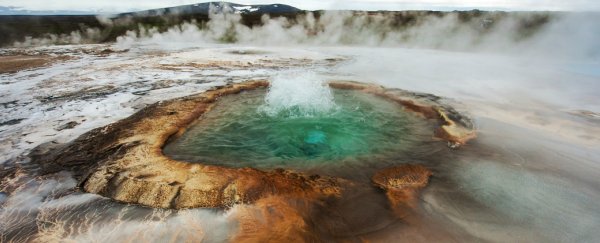The conditions that led to the first organisms evolving from the Earth's 'primordial soup' of chemicals around 3.6 billion years ago are pretty mysterious, but scientists have just found a major clue that could explain how life originated on our planet.
According to new research, before the evolution of RNA and DNA, simple protein chains known as peptides would have arisen from the boiling stew of amino acids - the building blocks of proteins - that formed shortly after Earth was created.
The new research contradicts one of the leading hypotheses on how life arose, known as the 'RNA world' hypothesis. This suggests that RNA molecules - which are made up of nucleotides, and play the crucial role of making proteins - first evolved from the primordial soup, and went on to turn amino acids building blocks into peptides. But scientists have struggled to work out exactly how that RNA could have evolved in the first place.
Now a pair of scientists believe that peptides may have actually arisen before RNA, if not at the same time, and may have even helped to construct the molecule.
Publishing across two separate papers in the Proceedings of the National Academy of Sciences (here and here), the team came to this conclusion after discovering a link between physical properties of the known 20 amino acids, and the nucleotides that make up RNA molecules. This suggests that billions of years ago, chains of amino acids and nucleotides could have interacted, and together may have produced the proteins and RNA that eventually made up the first single-celled organism.
"Our work shows that the close linkage between the physical properties of amino acids, the genetic code, and protein folding was likely essential from the beginning, long before large, sophisticated molecules arrived on the scene," one of the lead researchers, Charles Carter, a biochemist from the University of North Carolina in the US, said in a press release. "This close interaction was likely the key factor in the evolution from building blocks to organisms."
This new work sheds some light on the 'desert of knowledge' that currently exists between the formation of amino acids around 4.6 billion years ago and the appearance of our oldest known common ancestor, a single-cell organism named LUCA that lived 3.6 billion years ago.
"We know a lot about LUCA and we are beginning to learn about the chemistry that produced building blocks like amino acids, but between the two there is a desert of knowledge," said Carter. "We haven't even known how to explore it."
Along with co-researcher and fellow biochemist Richard Wolfenden, Carter has now made some impressive first steps into the unknown.
The two teams looked at particular physical properties of amino acids that control how proteins fold, and found that, even at the 100 degrees Celsius temperatures that would have been expected in the earliest days of Earth, parts of the amino acids would have been able to interact with the nucleotides that make up RNA. These interactions could have favoured the development of peptides that have a special affinity for RNA.
"Wolfenden established physical properties of the 20 amino acids, and we have found a link between those properties and the genetic code," said Carter. "That link suggests to us that there was a second, earlier code that made possible the peptide-RNA interactions necessary to launch a selection process that we can envision creating the first life on Earth."
There's still a lot we don't understand about how nucleotides and those 20 simple amino acids worked together to turn into all the complex proteins we see on Earth today, but the picture is finally becoming a little clearer.
"The collaboration between RNA and peptides was likely necessary for the spontaneous emergence of complexity," said Carter. "In our view, it was a peptide- RNA world, not an RNA-only world."
